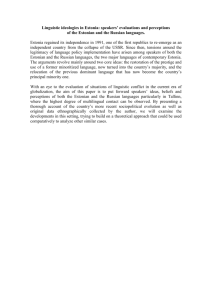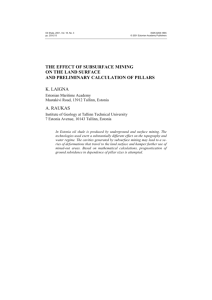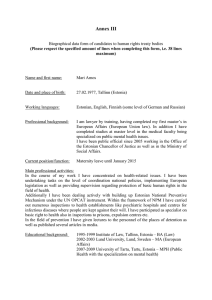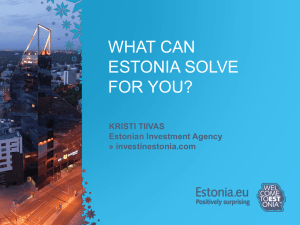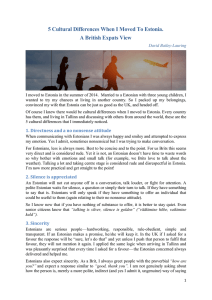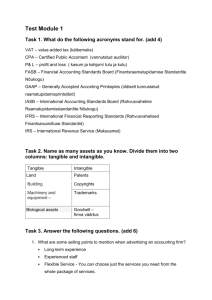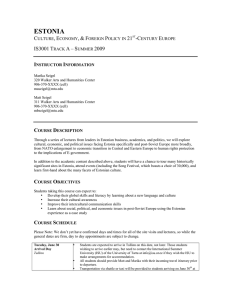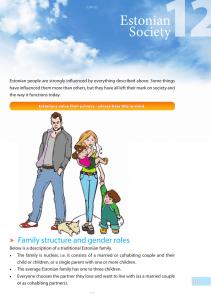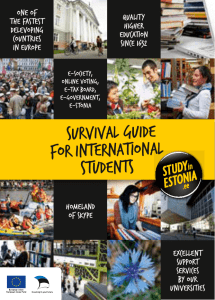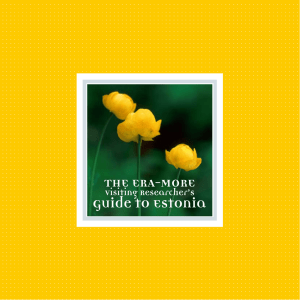1986, 1991, 1996 What else do you know about Estonia?
advertisement
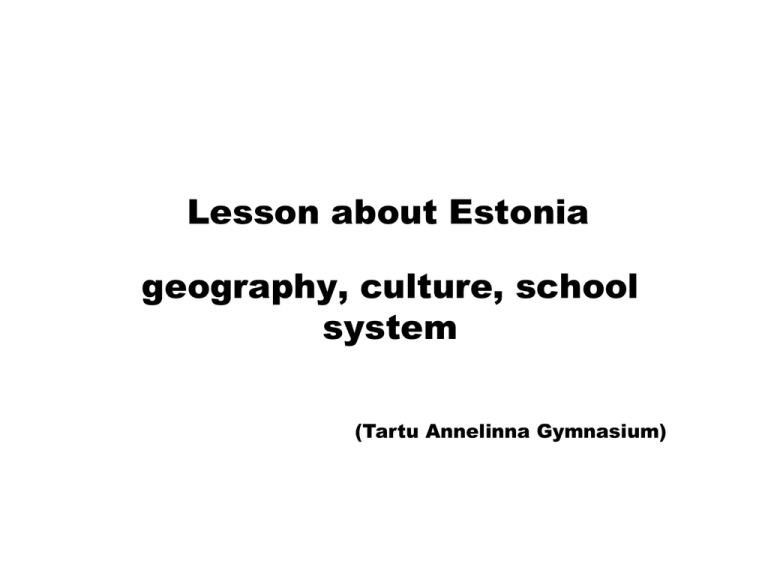
Lesson about Estonia geography, culture, school system (Tartu Annelinna Gymnasium) Here we are About Estonia z Find right neighbours! Finland, Sweden, Great Britain, Poland, Lithuania, Latvia, Russia, Belarus, Germany. z Which version is right? Area – 35 thousand square km; 45; 55 Capital city – Tartu, Riga, Vilnius, Tallinn, Population – 1,4 million; 2,4 million; 6 million Percentage of Estonians in population – 48%; 68%; 88% Three biggest minority groups: Finns, Latvians, Russians, Swedes, Ukrainians, Jews, Belarusians, Gypsies. Re-independence – 1986, 1991, 1996 z What else do you know about Estonia? General features of Estonian nature z z Estonia is a big/small country. It lies to the north/south of Finland . The average temperature in July is +25 degrees/ -5 degrees/ +17 degrees. z Estonia is washed by The Baltic Sea/The Mediterranean Sea/ The Red sea. Estonia has 10/ 83/ 1500 islands. The largest of these are Saaremaa, Hiiumaa, Muhu and Vormsi. z There are lots of huge montains in our country/ There are no high mountains in Estonia. Suur Munamägi (Great Egg Hill) is 7.855m/4.000m/318m. There are lots of natural lakes (1200)/ few lakes(16) in Estonia. z Forests cover one half/one tens of Estonia. The most common types of trees are pine, spruce and birch. z There are some 11 700 elk, 50 000 roe deer, 17.000 wild boar, 17 000 beavers, 800 lynxes, 600 bears and 100 volves. Absolutely adorable! TALLINN Tallinn is our medieval capital with a population of 40 000. z z Tallinn’s Old Town is in the list of UNESCO World Heritage Sites. It is ranked as a global city and has been listed among the top 10 digital cities in the world Tartu – city of good thoughts, with 100 000 people, is our university town Historical names are Tarbatu, Yuryev and Dorpat. It’s home of the oldest university Kissing students Tartu Hall square Regions z Besides large areas there are a number of small regions with a very specific character of their own. The most distinctive region is which is located in southeastern Estonia. Setumaa Regions z Another peculiar area was Mulgimaa, the central part of the former Sakala county. In this region many things, such as patterns dating back to the Middle Ages, sacrificial gardens, were preserved for a long time. Some of the ancient dishes originating from this region (e.g. Mulgi cabbage, curd cakes, and kama – roast mixed grains) have become popular all over Estonia. z Although the term “mulk” probably came from the Latvian word for “fool,” historically the people of Mulgimaa were wealthy, well educated and more likely to hold influential positions. Mulgimaa costume Belts and mittens Mensenkamff chapel Fascinating facts z Estonian culture as an identity is very strong. Oral traditions have played a key role in preserving traditions,stories and customs. Singing is a very Estonian activity. z Some people think that the Estonian language is a nightmare to learn-) z Estonia has a population of just 1.3 million but is larger then Denmark or Holland. z In winter it gets very cold and we have plenty of beautiful snow. No, there are no polar bears in Estonia! z Estonians on the whole are quiet and reserved. They tend to speak slowly and do not like to draw attention to themselves. Being rational,calm and not going to emotional extremes are all qualities that respected. z Estonians are quite formal and may not come across as quote cold or even friendly to people from more informal cultures. This should not be interpreted so. z z Once the relationship warms up the communication style becomes a lot less stiff. Estonians mean what they say and do what they say they will do. z Estonians are not emotive speakers. If you are from a culture where hand gestures are robust, you may wish to moderate them to conform to local practices. z z Passive silence is very much part of the communication style. They are slow to pay compliments and may become suspicious of compliments offered too readily and without sufficient reason. And finally, Estonians are mostly blond with light grey eyes. Estonian general education system z Preschool - … 7 years z Primary school (compulsory) – 7 – 16 years (9 grades) z Gymnasium – 16 – 19 years (3 grades) Schools by language of instruction 2012 / 2013 2,27% 14,73% Estonian schools Russian schools Mixed schools 83,00% Early total immersion program 100% 50% 0% I II III IV V VI Lessons in Russian 0% 10% 16% 24% 39% 44% Foreign language 0% 0% 12% 12% 12% 12% 100% 90% 72% 64% 49% 44% Lessons in Estonian Early partial immersion program 100% 80% 60% 40% 20% 0% I II III IV V VI VII VIII IX Lessons in Russian 10 12 11 11 13 14 13 15 16 Foreign language 0 0 3 2 3 3 3 3 3 Lessons in Estonian 10 11 11 12 12 13 14 14 15 Composition of curriculums by languages (Grades 1-3) 100% 80% 60% 40% 20% 0% Lessons in Russian Foreign language Lessons in Estonian Ordinary program 91% 0% 9% Partial immersion 48% 4% 48% 9% 4% 87% Total immersion 05.05.2013 z Nationwide day of garbage collection in 2008 Brainstorming 2009 Day of useful things «Teeme ära» ( «Let’s do it») in 2013 z Useful work done 1241 z 36,270 people participated Thank you!
